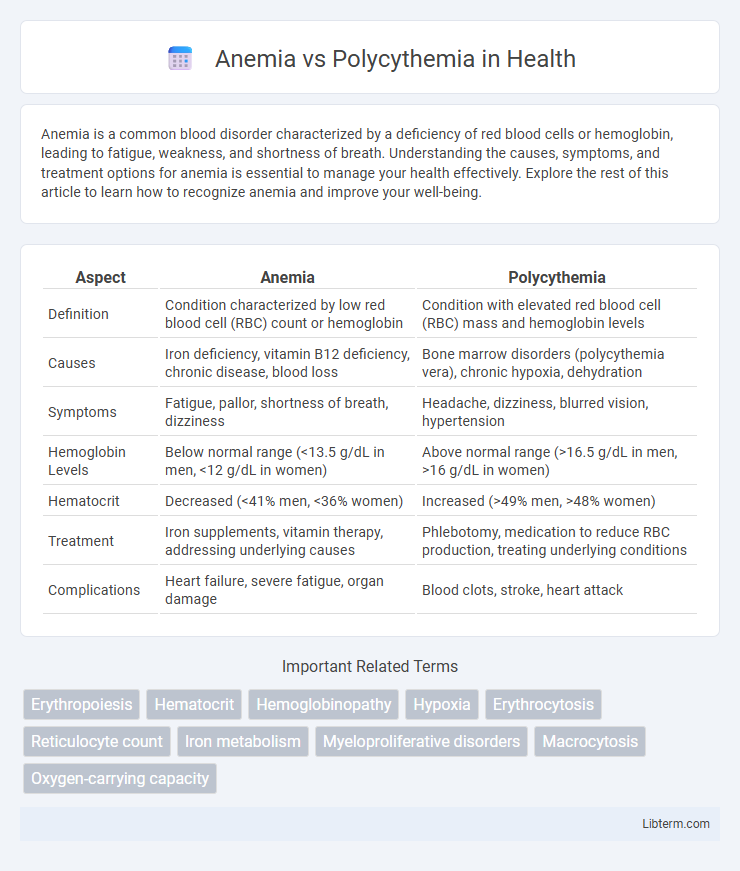Anemia is a common blood disorder characterized by a deficiency of red blood cells or hemoglobin, leading to fatigue, weakness, and shortness of breath. Understanding the causes, symptoms, and treatment options for anemia is essential to manage your health effectively. Explore the rest of this article to learn how to recognize anemia and improve your well-being.
Table of Comparison
| Aspect | Anemia | Polycythemia |
|---|---|---|
| Definition | Condition characterized by low red blood cell (RBC) count or hemoglobin | Condition with elevated red blood cell (RBC) mass and hemoglobin levels |
| Causes | Iron deficiency, vitamin B12 deficiency, chronic disease, blood loss | Bone marrow disorders (polycythemia vera), chronic hypoxia, dehydration |
| Symptoms | Fatigue, pallor, shortness of breath, dizziness | Headache, dizziness, blurred vision, hypertension |
| Hemoglobin Levels | Below normal range (<13.5 g/dL in men, <12 g/dL in women) | Above normal range (>16.5 g/dL in men, >16 g/dL in women) |
| Hematocrit | Decreased (<41% men, <36% women) | Increased (>49% men, >48% women) |
| Treatment | Iron supplements, vitamin therapy, addressing underlying causes | Phlebotomy, medication to reduce RBC production, treating underlying conditions |
| Complications | Heart failure, severe fatigue, organ damage | Blood clots, stroke, heart attack |
Introduction to Anemia and Polycythemia
Anemia is a condition characterized by a decrease in the number of red blood cells or hemoglobin, leading to reduced oxygen transport in the bloodstream and symptoms like fatigue and pallor. Polycythemia involves an abnormal increase in red blood cell mass, which can cause blood thickening, increased risk of thrombosis, and complications such as headaches and dizziness. Both disorders affect oxygen delivery but arise from opposite disruptions in red blood cell production or destruction.
Definitions and Key Differences
Anemia is a condition characterized by a decreased number of red blood cells or hemoglobin concentration, leading to reduced oxygen transport in the body. Polycythemia involves an increased red blood cell mass, resulting in thicker blood and potential complications like thrombosis. Key differences include anemia causing fatigue and pallor due to insufficient oxygen delivery, while polycythemia may cause headache, dizziness, and an elevated hematocrit level indicating excess red blood cells.
Causes of Anemia
Anemia is primarily caused by factors such as iron deficiency, chronic diseases, vitamin B12 or folate deficiency, and bone marrow disorders, which impair red blood cell production or lead to excessive destruction. Blood loss from trauma, menstruation, or gastrointestinal bleeding can also reduce red blood cell count, resulting in anemia. In contrast, polycythemia involves an elevated red blood cell mass, often due to genetic mutations like JAK2 or chronic hypoxia.
Causes of Polycythemia
Polycythemia is primarily caused by an overproduction of red blood cells stemming from either primary factors like polycythemia vera, a myeloproliferative disorder linked to JAK2 gene mutations, or secondary factors such as chronic hypoxia from lung disease, high altitude living, or tumors secreting erythropoietin. Unlike anemia, which involves a deficiency in red blood cells or hemoglobin, polycythemia results in increased blood viscosity, contributing to complications like thrombosis and hypertension. Understanding these etiologies is crucial for differentiating polycythemia from anemia and guiding appropriate treatment strategies.
Signs and Symptoms Comparison
Anemia presents with symptoms such as fatigue, pallor, shortness of breath, and tachycardia due to decreased red blood cell count and reduced oxygen delivery. Polycythemia is characterized by headaches, dizziness, pruritus, and a ruddy complexion, resulting from increased red blood cell mass and blood viscosity. Both conditions affect oxygen transport but exhibit contrasting clinical signs reflecting their distinct hematologic imbalances.
Diagnostic Approaches
Anemia diagnosis relies heavily on complete blood count (CBC) to assess hemoglobin concentration, hematocrit, and red blood cell indices, with reticulocyte count and iron studies providing further insight into etiology. Polycythemia is diagnosed through elevated hemoglobin and hematocrit levels on CBC, with erythropoietin measurement, JAK2 mutation analysis, and arterial oxygen saturation tests helping differentiate primary from secondary causes. Bone marrow biopsy may be necessary in ambiguous cases to evaluate marrow hyperplasia or fibrosis, aiding in accurate classification and treatment planning.
Treatment Strategies for Anemia
Anemia treatment strategies primarily involve addressing the underlying cause, such as iron supplementation for iron-deficiency anemia, vitamin B12 or folate supplementation for megaloblastic anemia, and managing chronic diseases contributing to anemia of inflammation. In cases of severe anemia, blood transfusions may be necessary to rapidly increase red blood cell levels. Erythropoiesis-stimulating agents (ESAs) are also used in anemia related to chronic kidney disease to stimulate red blood cell production.
Treatment Strategies for Polycythemia
Treatment strategies for polycythemia primarily include therapeutic phlebotomy to reduce hematocrit levels and minimize blood viscosity, improving circulation and decreasing the risk of thrombosis. Cytoreductive therapy with agents like hydroxyurea is often prescribed for high-risk patients to control excessive red blood cell production. Lifestyle modifications and regular monitoring of hematologic parameters are essential to prevent complications and manage disease progression effectively.
Complications and Prognosis
Anemia can lead to complications such as fatigue, heart palpitations, and increased risk of heart failure due to insufficient oxygen delivery to tissues. Polycythemia increases blood viscosity, raising the risk of thrombotic events like stroke, myocardial infarction, and deep vein thrombosis. Prognosis in anemia depends on underlying cause, with untreated cases worsening outcomes, while polycythemia requires management to prevent vascular complications and improve survival rates.
Preventive Measures and Lifestyle Tips
Maintaining a balanced diet rich in iron, vitamin B12, and folate helps prevent anemia by supporting healthy red blood cell production, while staying hydrated and avoiding excessive tobacco use reduces the risk of polycythemia by preventing blood thickening. Regular physical activity enhances circulation and oxygen delivery, benefiting both conditions by improving overall cardiovascular health. Routine medical check-ups with complete blood counts enable early detection and management of abnormal red blood cell levels, minimizing complications associated with anemia and polycythemia.
Anemia Infographic

 libterm.com
libterm.com